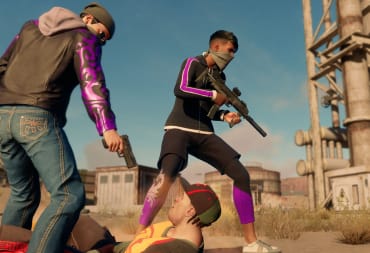The latest Saints Row is the industry’s latest harsh lesson on how not to do a reboot. It is a mess of a game, one of the most obviously unfinished AAA releases of the last few years. The game-breaking bugs force you to quit out and rethink your choices every hour like clockwork. The default settings make the mediocre shooting feel so much worse than it actually is, requiring you to turn off the auto aim and adjust the dead zones for combat to feel functional.
If you can overcome the technical issues, you'll find bland characters and jokes with 100% failure to launch. Even at its most absurd, this game's silliest moments fail to measure up to even the tamest set pieces in Saints Row: The Third. A game series known for its bombast and self parody has been sanded down to quips and retreads of missions from the last 15 years of Grand Theft Auto and its imitators.
The launch of Saints Row (2022) has upset fans, some for good reason, some for insipid ones. But beyond the amplified voices screaming "woke," you’ll find that there might actually be some things worth liking about the game. What I connected most with was the setting of Santo Ileso, a mashup of cities from an under-explored region in open-world games. The excellently rendered and conceptualized setting ultimately serves to make the latest Saints Row all the more disappointing.
This Part of America Is Underrepresented in Games
The Las Vegas inspired Santo Ileso brings Saints Row to the American Southwest. This region and specifically a city like Vegas would be the perfect setting for a larger-than-life Saints Row sequel. It has the potential to provide players with ridiculous set pieces as well as new twists on the property investment system that has become a series staple. Instead, the setting seems to have no influence on the untouched Saints Row structure. Take down the gangs that control the area. Build more property to expand the Saints empire.
.jpg?itok=BX3cCpvd)
From RV meth labs to Los Pollos Hermanos parodies, Saints Row is littered with references to Breaking Bad. This reinforces what already feels like a New Mexico influence on top of the obvious Vegas analogue. The topography also reads more Arizona than Nevada a majority of the time. But as the day cycles to night, the effect of the bright city as a beacon in the middle of the desert is replicated in Santo Ileso.
It’s a part of the country rarely depicted in games. Rainbow Six: Vegas, Fallout: New Vegas, and Dead Rising 2 take place in Vegas, but New Vegas is the only one of those where you spend a large portion of time outside the city. GTA: San Andreas has a Las Vegas analogue, but that game is still mostly California.
The specific type of adobe-building-strewn neighborhoods that you find in Saints Row (2022) aren’t depicted in many games outside of Red Dead Redemption. And while this doesn’t boast the fidelity of Rockstar’s last mega-hit, the world of Santo Ileso is detailed enough to evoke real-life memories of time spent in this region. In gameplay-relevant terms, this helps the random shootout with the cops at the gas station feels more like Breaking Bad than generic action game 42.
Admittedly, the most positive reviews of Saints Row have noted this setting as a major positive impact on the overall experience. Still, despite its attention to detail and evocation of relevant pop culture, the setting feels wasted on a dull and lifeless gameplay experience.
Santo Ileso Has Untapped Potential for Chaos
If it was 2012 and you told me the sequel to Saints Row: The Third would be set in a Vegas-esque city, there would be certain expectations for the kind of antics the Saints would get into in Sin City. The specific type of lewd rowdiness anyone who’s been to the Vegas Strip knows about goes hand in hand with the Saints Row style of humor. It is gaudy and edgy. It’s trying to make a certain type of person uncomfortable. And yet, like a Saints Row game, the whole Vegas Strip is a sandbox for tourists. Sometimes you can even live out your wildest fantasies. In a lot of ways it is the perfect setting for a new Saints Row. So what went wrong?
.jpg?itok=p_pntByP)
All these words used to describe all the previous Saints Row games can’t be applied to the reboot. It is not lewd or edgy. It barely manages to get to silly and clears the bar less than half the time. It’s not that Saints Row (2022) is overly serious in its tone, but the lack of jokes only leaves us with a group of selfish, unlikeable characters left to try and relate to.
The best Saints Row games have missions that match this tone. They are funny and bombastic in unexpected ways. The ridiculous high points of the series, see: Saints Row IV, are defined by a constant string of fresh and creative takes on both the presentation and gameplay. This creativity is nowhere to be found in the reboot.
Even when you assault your final adversary in a casino in the last mission, it still plays out as a bog-standard mission. You are shooting the same enemies you have been for the past 20 hours up until the final congratulatory cutscene that ultimately tells you there is more of the same game to play. Yay.
Is this whole article a stealthy way for me to critique the mission design? Well, yes, sort of. The core issue at the heart of the matter is that the mission requirements rarely rise above requiring you to slaughter a bunch of enemies either on foot or with some type of vehicle. By and large, the missions feel uninspired and rote, and by Saints Row standards, this is a criminal offense. The mission design is as important to expressing the personality of the game as the writing. That’s what makes Saints Row work.
Having a potential list of appropriately grandiose ideas seemingly within arms reach by virtue of the game’s setting makes the milquetoast results even more crushing. While moments of running around Santo Ileso sparked joy, it was mostly a place of wasted potential. And like the real desert of the American Southwest, bugs. Lots of bugs.
Have a tip, or want to point out something we missed? Leave a Comment or e-mail us at tips@techraptor.net
_0.jpg?itok=rQYGZdXR)










